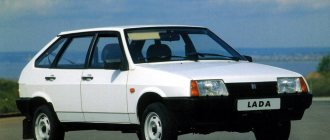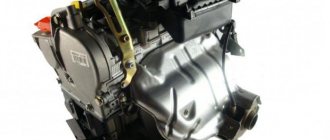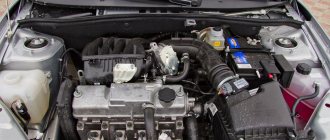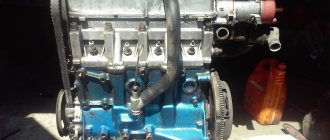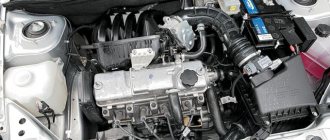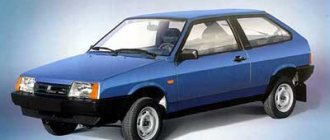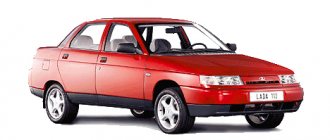The VAZ 2123 Niva Chevrolet engine is a steel heart with a good resource. The car of this brand received an improved engine from AvtoVAZ. In it, the mechanism, consisting of 4 cylinders, is located vertically. The power unit has a fuel mixture injection control system and passed all European tests, according to the results of which it was assigned to the Euro 2 standard. The new VAZ 2123 engine, unlike other modifications, is famous for its low noise level. To do this, engineers had to use hydraulic chain tensioners in the design, as well as use single-row chain devices. The integration of the hydraulic valve support also contributed to the reduction in engine noise.
Technical characteristics of the VAZ 2123 engine
The VAZ 2123 power unit has a working volume of 1690 cubic meters. cm. It is naturally aspirated and runs on gasoline fuel. His weight is 127 kilograms. The electronic fuel injection system increased engine power to 80 hp, and the torque is 127 NxM, which becomes available at around 4000 rpm.
On the highway the car can reach a speed of 140 km/h. A five-speed manual gearbox is responsible for shifting gears. Highway consumption does not exceed 8.5 liters per 100 km. In the city it increases to 14 liters per 100 kilometers. In such an engine, for its stable operation and responsive traction, it is recommended to fill AI-95 gasoline.
A timing belt with a hydraulic chain tensioning system requires increased oil pump performance. To increase productivity without increasing power, engineers reduced the number of teeth on the pump drive gear.
To lubricate the engine, 3.5 liters of oil is required. Both synthetic and semi-synthetic oils are suitable. The only thing that requires attention is the viscosity indicator, which must correspond to the 5W30 index. To preserve the life of the Chevrolet Niva engine for many years, it is recommended to change the oil every 10,000 km.
Reliability, weaknesses, maintainability
Reliability
VAZ-2123 is considered a reliable engine. Car owners are satisfied with its technical characteristics and high throttle response.
The main factors characterizing the reliability of any motor are the mileage before major repairs and the safety margin, i.e. the ability to boost the motor.
From Table 1 it can be seen that the unit does not have any problems with these parameters. Car enthusiasts on forums confirm this. For example, forum member V writes: “... I have a Chevy, 350 thousand without cap. repairs, 1.5 liters of oil from replacement to replacement, at 240 the cylinder head was replaced and that’s all…”. His communication colleague P supports: “... the engine (this is subjective) is able to last up to 300 thousand km. (how to ride and how to follow).”
The manufacturer keeps internal combustion engine reliability issues under constant control. Each engine improvement includes developments that increase reliability. So, the pump was replaced, the pan and air intake system were changed, and other improvements were made.
Updating engine components is also aimed at increasing the reliability and durability of the unit. For example, the timing chain has a service life of 150 thousand km (which cannot be said about its tensioner), the working surface of the pistons has an applied layer of tin, and when they meet the valves, the latter do not bend.
Car owners emphasize the need for proper engine maintenance. The service life without repair depends on its quality and timeliness.
VAZ-2123 is easy to tune. But here you need to remember two points:
- The engine design is aimed at high cross-country ability of the vehicle, not speed.
- Increasing power significantly reduces engine life and increases fuel consumption.
At the same time, a simple flashing of the ECU allows you to increase power by 15-20 hp. With.
Weak spots
The most noticeable weak points of the engine are considered to be the following:
- Noisy operation of a cold internal combustion engine. In most cases, this phenomenon is caused by the operation of hydraulic compensators. Unfortunately, they are structurally flawed, their quality leaves much to be desired. The defect is eliminated by replacing the hydraulic compensators or removing them altogether and replacing them with mechanical pushers.
- Loud engine operation at idle. In addition to low-quality hydraulic compensators, the source may be the hydraulic timing chain tensioner. It is advisable to get rid of the problem as quickly as possible, since the consequences can become quite serious (jumping or broken circuit). The malfunction is eliminated by replacing failed parts. Some car enthusiasts throw away the hydraulic tensioner and install an ordinary mechanical one instead.
- Engine tripping is often observed, especially at idle speed. The cause of the phenomenon must be sought in the ignition system module, burnt-out valves or hardened valve stem seals. The prerequisites for tripping are serious; their identification is possible only with a thorough diagnosis of the unit.
- It happens that the engine stalls after starting and will not start again. This is usually observed when the throttle sensor fails. With its replacement, the problem disappears in most cases.
The VAZ-2123 has several more weaknesses, but they appear less frequently. These include short-lived oil and water pumps, various sensors (XX, MAF, etc.).
VAZ 2123 engine - features
The VAZ 2123 engine for the Chevrolet Niva has received many changes that have a better effect on its functional characteristics.
Unlike its predecessor models, it has a different generator location. He is now on top.
1 — oil pan; 2 — main bearing cover; 3 — connecting rod cover; 4 - crankshaft; 5 — connecting rod; 6 - piston; 7 — piston rings; 8 - valve; 9 — valve guide; 10 — valve springs; 11 - plate; 12 - camshaft; 13 — cylinder head cover; 14 — valve lever; 15 - hydraulic support; 16 — cylinder head; 17 — spark plug; 18 — cylinder head gasket; 19 — generator bracket; 20 — cylinder block; 21 — oil pump gear retainer; 22 — oil pump gear; 23 — oil filter bracket; 24 — oil pan gasket; 25 - oil pump
The new cylinder block is based on the old one, but despite this it has its own marking. The main change affected the way the oil filter is mounted. In older models it was screwed directly into the block, but now a special bracket is used for connection. It performs another function - it is a support for mounting the power steering pump.
The flywheel received an increased diameter, as a result of which its working surface became 215 mm.
A new pump has been installed, inside of which a roller bearing is located. Unlike the old ball bearing, the new type of bearing has an increased service life.
The water pump, power steering pump and generator are driven by a pulley mounted on the crankshaft. The system includes tension and support rollers. The pulleys themselves are made according to a special design, adjusted to the belt profile.
1 — tension roller of the air conditioning compressor drive belt; 2 — air conditioning compressor drive belt; 3 — air conditioning compressor clutch; 4 — thermostat; 5 — throttle assembly; 6 — outlet pipe of the cooling jacket; 7 — coolant pump pulley; 8 - phase sensor; 9 — tension roller for the auxiliary drive belt; 10 — cylinder head; 11 - generator; 12 — power steering pump pulley; 13 — support roller for the auxiliary drive belt; 14 — cylinder block; 15 — auxiliary drive belt; 16 — crankshaft position sensor; 17 — auxiliary drive pulley; 18 — air conditioning compressor drive pulley; 19 — oil pan; power unit support; an exhaust manifold; receiver; cylinder head cover;
Changes also affected the design of the engine compartment. The front axle gearbox is no longer attached to the engine. This required changes to the internal engine compartment.
ShPG design features
The ICE 2123 uses a connecting rod and piston group from the VAZ 21213 engine. The crankshaft guarantees a piston stroke of 80 millimeters. Its marking remained unchanged 21213-1005015. The crankshaft damper pulley, designated 2123-1005058, is designed to work with a poly V-belt. To determine the position of the crankshaft, the pulley is supplemented with a toothed disk. Using the teeth of this disk, a special sensor monitors the position of the crankshaft. The damper is needed to reduce oscillatory vibrations when the crankshaft rotates and reduce the noise of the internal combustion engine. The flywheel of the new internal combustion engine has a large diameter, the working surface of which is 215 millimeters.
Motor device
Briefly about how the VAZ 2123 Chevrolet Niva engine works.
Cylinders
They were combined with the upper part of the crankcase. Like most VAZ engines, this power unit has cylinders operating in a 1-3-4-2 pattern. The lower part of the cylinder block is connected on five supports to the crankshaft.
1 — tension roller of the air conditioning compressor drive belt; 2 — air conditioning compressor drive belt; 3 — air conditioning compressor clutch; 4 — thermostat; 5 — throttle assembly; 6 — outlet pipe of the cooling jacket; 7 — coolant pump pulley; 8 - phase sensor; 9 — tension roller for the auxiliary drive belt; 10 — cylinder head; 11 - generator; 12 — power steering pump pulley; 13 — support roller for the auxiliary drive belt; 14 — cylinder block; 15 — auxiliary drive belt; 16 — crankshaft position sensor; 17 — auxiliary drive pulley; 18 — air conditioning compressor drive pulley; 19 — oil pan; power unit support; an exhaust manifold; receiver; cylinder head cover;
Crankshaft
Five-legged. Cast from cast iron. If necessary, the journals can be reground with a diameter reduction of 0.25; 0.50; 0.75 and 1 mm.
Exhaust valves
Welded in two parts. One is an alloy of chromium, nickel and molybdenum, and the other is made of multi-component steel. The operating temperature of the exhaust valves is 700-900 degrees, since during engine operation they are heated by processed gases. In order for them to withstand such temperatures, a special heat-resistant alloy is applied to them.
Intake valves
Their rods are treated with nitrogen and hardened under the influence of high frequency current. This is enough to withstand operating temperatures of 350-500 degrees.
Pistons
The VAZ 2123 engine has pistons cast from an aluminum alloy. A layer of tin is applied to them to make the process of breaking in the car faster. The piston stroke is 80 mm, and it itself has a diameter of 82 mm. The compression ratio is at 9.3 atmospheres.
Camshaft
Cast from cast iron and installed in a removable aluminum housing. Its rotation is carried out by a single-row roller chain.
It is stretched by a spring-hydraulic tensioner. Its size has increased significantly. Until the engine starts, the tension is carried out by a spring, and during its operation it is provided by oil pressure.
Cylinder head
Attached to the block itself with 11 bolts. Centering is performed using the power of two bushings.
Lubrication system
It is carried out using the pressure and spray method, which helps to save oil.
Crankcase ventilation system
Closed, and crankcase gases are discharged through the oil separator into the intake pipe. From there they are transferred to cylinders and burned.
Cooling system
The fluid circulation is forced and is produced using a centrifugal pump.
Ignition system
Controlled by an electronic unit. The ignition module is located on the cylinder block and is powered by the battery.
Timing belt design features
The timing shaft is used from a VAZ 21214. Its drive, along with the oil pump drive, is carried out by a single-row roller chain. Accordingly, all timing drive sprockets installed on the engine are made of single-row sprockets. The oil pump sprocket is smaller, resulting in increased pump performance. Increased MH performance is needed for the correct operation of hydraulic pushers. The spring-hydraulic chain tensioning mechanism is borrowed from the VAZ 21214 engine.
What engine is on the Chevrolet Niva
The main design feature of this internal combustion engine is its vertical location under the hood of the car. Fuel injection into 4 cylinders is carried out under the control of a special electronic system built into the engine. Compared to its predecessors, the new modification of the VAZ-2123 engine is much quieter. This is due to the following factors:
- its design includes a hydraulic chain tensioning mechanism;
- single-row arrangement of the chain device;
- valve hydraulics have a special support;
- Knock sensors are installed on the cylinder head bosses of the Chevrolet Niva engine.
Technical characteristics of the Chevrolet Niva:
- Engine power – 80 horsepower.
- Engine volume – 1690 cm3.
- The capacity of the gasoline tank is 58 liters.
- The maximum speed of the car is 140 km/h.
- Developed torque – 127.5 N.m.
- Compression ratio – 9.3 atm.
- Number of cylinders – 4 pcs.
- The total number of valves is 8 pcs.
- Cylinder diameter – 82 mm.
- The minimum stable crankshaft speed is 750 rpm.
- Motor weight – 127 kg.
Depending on operating conditions, the Chevrolet Niva engine consumes fuel per 100 kilometers:
- on country roads - no more than 8.8 liters;
- on city streets - up to 14.1 l;
- combined road conditions - no more than 10.8 liters.
Relay and fuse box
The mounting block with fuses and relays is mounted on brackets to the left of the steering column and closed with a lid from below. To access the unit, remove its cover by unscrewing the screws.
Mounting block 2110-3722010-08
Mounting block 2110-3722010-01
Mounting block 2123-3722010 since 2009
| № | Current, A | Purpose | |
| 1 | 5 | License plate light lamps Instrument lighting lamps External lighting warning lamp in the instrument cluster Engine compartment lamp Additional brake signal lamp Left side side light lamps | |
| 2 | 7.5 | Low beam lamp (left headlight) Electrical headlight corrector Motorized corrector | |
| 3 | 7.5 | High beam lamp (left headlight unit) Indicator lamp for turning on the high beam headlights | |
| 4 | 10 | Left fog lamp | |
| 5 | 30 | Power window relay Power windows | |
| 6 | 15 | Before 2009: Door lock control unit From 2009: Cigarette lighter | |
| 7 | 20 | Cigarette lighter (Before 2009) Horn relay Horn light Trunk light (Since 2009) | |
| 8 | 20 | Before 2009: Rear window defroster relay (contacts) Rear window defogger element | |
| 8 | 25 | From 2009: Heated tailgate glass element Heated tailgate glass relay Heated outside rear view mirror elements | |
| 9 | 20 | Tailgate heated glass switch (Since 2009) Windshield wiper relay Windshield wiper motor Windshield washer pump Right steering column switch Glove box light Reversing lamps (Since 2009) Headlight wiper relay (contacts; before 2009) Headlight wiper motors (until 2009) Electric headlight washer motor (until 2009) | |
| 10 | 20 | Before 2009: Reserve Since 2009: Electrical accessories remote control unit (door lock) | |
| 11 | 5 | Tail lamps Instrument lighting control | |
| 12 | 7.5 | Low beam lamp (right headlight) Corrector motor gearbox (right headlight) | |
| 13 | 10 | High beam lamp (right headlight) | |
| 14 | 10 | Right fog lamp | |
| 15 | 20 | External mirror control unit Electric external rear view mirrors External mirror control unit | |
| 16 | 10 | Relay-breaker for direction indicators and hazard warning lights (in hazard warning mode) | |
| 17 | 7.5 | Individual lighting lamp Immobilizer warning lamp Brake lamps Additional brake light Interior lighting lamp | |
| 18 | 25 | Before 2009: Reversing lamps Heater fan Windshield washer motor Rear window defroster relay (coil) Rear window wiper relay Rear window wiper motor Rear window washer motor Door lock control unit | |
| 18 | 25 | From 2009: Heater motor switch Heater motor | |
| 19 | 10 | Relay-interrupter for direction indicators and hazard warning lights (in turn signal mode) Instrument cluster (except for the engine management system fault warning lamp) Differential lock warning lamp Starter relay (Since 2009) | |
| 20 | 7.5 | Fog lamps in the rear lights Anti-theft system control unit (Since 2009) Buzzer (Since 2009) | |
| Relay | |||
| K1 | From 2009: Windshield wiper relay Before 2009: Relay for monitoring the health of lamps (jumpers are installed instead of relays) | ||
| K2 | From 2009: Turn signal and hazard warning light relay Before 2009: Windshield wiper relay | ||
| K3 | From 2009: Low beam headlight relay Before 2009: Turn signal and hazard warning light relay | ||
| K4 | From 2009: High beam relay Before 2009: Low beam relay | ||
| K5 | From 2009: Auxiliary relay (Tailgate defroster relay coil, heater fan, windshield wiper and washer, tailgate wiper and washer) Before 2009: High beam relay | ||
| K6 | From 2009: Heated tailgate glass relay Before 2009: Additional relay (Relieves the ignition switch contacts) | ||
| K7 | Heated tailgate glass relay | ||
| K8 | Reserve | ||
Remote relays on the mounting block before 2009:
- Power window relay
- Fog light relay
- Auto horn relay
- Power exterior mirror relay
Remote relays on the mounting block since 2009:
- Fog light relay
- Power window relay
- Seat heating relay
- Horn relay
- Starter relay 2123
Additional fuse block
Additionally, under the instrument panel on the passenger side there are relay blocks with fuses that protect the elements of the injection system.
- Additional relay (turns on the right electric fan through an additional resistor at low rotation speed);
- Fuse (50A) protecting the power circuits of the additional relay and the right electric fan relay;
- Fuel pump (fuel pump) fuse (15A), protecting the power circuits of the electric fuel pump relay;
- Fuse (15A) protecting the constant power supply circuit of the controller;
- Right electric fan relay;
- Left electric fan relay;
- Electric fuel pump relay;
- Main relay 2123 Niva;
- Fuse (50A) protecting the left electric fan circuits;
- Fuse (15A) protecting power circuits switched on by the main relay;
- Controller
Mounting block connection diagram
The outer number in the designation of the wire tip is the number of the block, and the inner number is the conventional number of the plug. In the diagram K1 is a relay for monitoring the health of the lamps (contact jumpers are shown inside, which are installed instead of the relay); K2 – windshield wiper relay; K3 – relay-interrupter for direction indicators and hazard warning lights; K4 – headlight low beam relay; K5 – headlight high beam relay; K6 – additional relay; K7 – relay for turning on the heated rear window; F1–F20 – VAZ-2123 fuses.
Fuse box diagram from 2022
The main problems of the Chevrolet Niva VAZ-2123 engine
Among the most common malfunctions are the following:
- The motor does not turn on.
- The engine stalls at idle and when driving.
- Reduced power of the power unit.
Reasons for startup problems:
- contamination of fuel lines (the system is washed with water or cleaned with compressed air);
- clogging of the fuel filter (the filter element is cleaned or replaced with a new device);
- the gasoline pump is broken, the unit has stopped pumping or supplies an insufficient amount of fuel (you need to install a new gasoline pump).
If the engine often stalls, this indicates a malfunction in the fuel pump, as well as the idle air regulator, which needs to be replaced with a new mechanism. The engine may also stop working if air gets into the gasoline hoses. In order to eliminate this defect, it is recommended to eliminate damage to the hoses and their fixation points, tighten the fastenings of the clamps, etc.
If a discrepancy between the engine power and the nominal values is detected, it is necessary to check the throttle valve adjustments and the condition of its position sensor. A faulty sensor cannot be repaired; it will simply need to be replaced with a new device. It is also recommended to check the serviceability of the engine ignition system (spark plugs) and the amount of battery charge.
Other transformations
Among other alterations and innovations in the version under consideration, the following points can be noted:
- Fuel mechanism with Siemens type injectors.
- The ignition module has not changed, it copies analogues from the period of modification 2112.
- The generator is marked with the serial number 9402.3701-01. The element has a top location.
- A model with index 5722.3708 is provided as a starter for ignition. The main feature of the unit is the presence of a planetary gearbox, the maximum power indicator is 1.55 kV.
- To protect the power unit, a reinforced plastic casing is provided.
Chevrolet Niva engine management system
Layout of sensors in the engine compartment of the vehicle, supplying information to the electronic control unit:
The control system includes the following sensors:
- liquid temperature in the cooling system (6);
- detonation (9);
- air mass flow (1);
- machine speed (13);
- throttle position (7);
- crankshaft (3);
- oxygen concentration (10) – “Lambda probe”.
Self-diagnosis
Without going into details of the operation of all electronics, we note that the functioning of all vehicle systems is “monitored” by an electronic control unit (ECU).
It receives information from numerous sensors. Like any computer, the ECU requires software called firmware. This firmware is capable of analyzing indicators received from sensors, comparing them with normal parameters, identifying errors and storing these errors in memory.
Carrying out self-diagnosis
In the Chevrolet Niva, as in some other cars of the VAZ family, some parameters can be displayed on the VDO dashboard. It is often called an integrated on-board computer.
Testing is started by first pressing the daily mileage reset button and simultaneously turning the ignition key.
All instrument needles begin to move, which indicates the beginning of the testing process. Pressing the same button once will cause the firmware version to appear on the display, and pressing it again will give us a reading called an error code.
Panel codes should not be confused with ECU codes, which are diagnosed by external devices.
| Error code | Decoding |
| 1 | Processor faults |
| 2 | No signal from the fuel level sensor |
| 4 | Increased voltage of the on-board network (exceeds 16 V) |
| 8 | Reduced voltage on-board network |
| 12 | Control indicator malfunction |
| 13 | No signal LAMDA probe |
| 14 | Increased coolant temperature |
| 5 | Reduced coolant temperature |
| 19 | Error from HF sensor |
| 21-22 | Error with TPS |
| 24 | Error from speed sensor |
| 27 — 28 | Incorrect CO potentiometer parameters |
| 23 — 25 | Error from intake air temperature sensor |
| 33 — 34 | Error from the MAF sensor |
| 35 | Error from sensor XX |
| 41 | Error from phase sensor |
| 42 | Ignition system malfunction |
| 43 | Error from knock sensor |
| 44 — 45 | Rich/lean fuel mixture |
| 49 | Loss of vacuum |
| 51 — 52 | ROM/RAM errors |
| 53 | No signal from CO potentiometer |
| 54 | No signal from the octane corrector |
| 55 | Load on the power unit |
The operation of the on-board computer cannot be called flawless, since many errors arise as a result of software failure. You have to reset the errors by holding down the daily mileage reset button in testing mode. This diagnostic method is not entirely convenient for the reason that the error code can be the result of the sum of two codes at the same time (10=8+2).
Increasing engine power in Chevrolet Niva
Some Chevrolet Niva owners are not always satisfied with some of the operating parameters and characteristics of the internal combustion engine. Considering the impressive weight of the vehicle and good cross-country ability, they believe that the power of 80 horsepower should be increased slightly. This figure can be increased with some improvements.
Refinement of the Chevrolet Niva engine in order to increase power is carried out in one of several ways:
- Replacement of original components and parts with tuning copies (change of engine configuration geometry).
- Installation of turbocharging.
- Chip tuning (reflashing ECU programs).
Thanks to modifications to the injector, mechanics achieve maximum increases in engine power and torque. In addition to power indicators, the motor gains improved acceleration dynamics. The response to driver control inputs is noticeably improved.
If they have some experience and sufficient qualifications, drivers carry out this work with their own hands:
- boring of cylinder liners (increase in volume from 1.7 to 1.9 liters);
- seats for valves of larger diameter;
- replacement of changed elements;
- reconfiguration of the fuel system (chip tuning).
Important: If the technician who tunes the Chevrolet Niva engine has insufficient experience and knowledge, working elements may break down and additional problems may arise that require expensive repairs.
Electronics
The new model received new electronic filling.
Bosch controller type MP 7.9.7 is now installed on cars. In older models you can find the domestic development “January” 7.2. Users will notice a more convenient interface that allows more precise control of fuel consumption; the engine develops higher dynamics thanks to a modified injection control system. It is also possible to install an injection phase system to reduce the amount of harmful emissions, optimize fuel consumption and comply with EURO-3 standards.
There are several basic ways to increase engine power. But they all involve some risk. Therefore, before carrying out work, you should carefully study all possible consequences:
- Increasing piston stroke. This allows you to increase the volume of the combustion chamber from 1.7 to 1.9 liters. To perform this procedure, you will need to bore the internal size of the sleeves. Then new pistons and rings are installed. Ideally, a new type of crankshaft should be installed on the car, which will have longer arms so that shortened connecting rods can be used. In addition, you will need to bore the intake and exhaust windows to install larger diameter valves.
- But in the end, the standard injection system will no longer supply the required amount of fuel and, as a result, the system will need to be reconfigured - chip tuning. All this can lead to a significant increase in fuel consumption, up to 15%.
- Upgrading the cylinders to match the efficiency of the updated piston system. This will require boring them to 84 mm. This in turn will require replacing a large number of related parts.
When manipulating the engine, it is worth remembering that the car itself is not designed for operation at high speeds. The car was created mainly to ensure high cross-country ability and develop the highest torque at lower engine speeds. Therefore, tuning to increase power will have a negative impact not only on most parts, significantly reducing their service life, but will also lead to faster wear of the transmission and suspension.
Features of Niva Chevrolet engine maintenance
The operational life of a Chevrolet Niva engine depends on timely, high-quality scheduled preventive maintenance. To save money, many drivers take care of their car, in particular the power unit, on their own, in a garage.
The list of main works includes measures to replace the following parts, assemblies, and consumables:
- Motor oil.
- Replacement air filter part.
- Antifreeze.
- Fuel filter.
- Brake fluid.
The list of mandatory operations also includes regular checking of the condition of such nodes:
- drive belts for the air conditioning compressor and other auxiliary mechanisms;
- pads, drums, brake discs of front and rear wheels.
If necessary, these parts must be dismantled and subsequently replaced with new copies.
Typical operating parameters of VAZ injection engines
Checking VAZ sensors is usually carried out when certain problems are detected in the operation of the controllers. For diagnostics, it is advisable to know what malfunctions of VAZ sensors can occur; this will allow you to quickly and correctly check the device and replace it in a timely manner. So, how to check the main VAZ sensors and how to replace them after that - read below.
Basic parameters of controllers on VAZ injection engines
How to change the oil in a Chevrolet Niva engine with your own hands
According to the maintenance regulations for this power unit, the oil should be changed after a travel distance of 15,000 kilometers. When operating the machine in difficult conditions, the time period is reduced to 7,500 km.
Measures to replace the lubricant are carried out with the engine turned off, a few minutes after the trip. The car must be located on a special elevated platform - an overpass.
- clean the drain plug located at the bottom of the oil pan;
- place a container to collect used lubricant;
- unscrew the plug;
- wait 10 - 15 minutes until the hot oil drains;
- dismantle the old one and install a new oil filter;
- clean the plug and screw it into its original place;
- pour a portion of new oil (3.5 - 3.7 liters) through the filler neck;
- wait 10 minutes and check the level using the oil dipstick (at this stage it should be at its maximum value);
- start the engine;
- check for oil leaks in the area of the filter and drain plug;
- turn off the engine;
- re-check the amount of lubricant (now the level between the MAX and MIN marks is considered normal);
- If necessary, add the missing oil.
After completing all the necessary steps, it is recommended to tighten the fastenings of the filter and drain plug.
Tip: When completely changing the engine oil, it is recommended to change the outdated filter element. Initially, the Chevrolet Niva engine is equipped with a Salyut 2108-1012005 oil filter. After the first maintenance of the motor, this unit is replaced with a MANN W920/21 filter made in Germany.
Computer diagnostics
The most complete diagnosis is possible with a computer or laptop. In order to use this method, you must purchase an adapter. This adapter performs two functions at once. It is an adapter from a K-line port to a USB port or to a COM port. It also acts as a decoder, which allows you to transmit signals from the ECU to the PC. You will also need to install the appropriate software on your laptop. There are a lot of free versions on the Internet. There are universal programs, as well as programs written for a specific car. After connecting to the computer, you will need to turn on the ignition and launch the program. The connection will happen automatically.
The interface of the computer program is very convenient and allows even an inexperienced user to navigate intuitively. All functionality can be divided into several sections. These are parameters, errors and settings. If the first two sections are informational, then using the third section you can control the vehicle systems.
Specifications and Features
The power unit that is installed on the Chevrolet Niva, as well as on the Niva 21214 and 21213 models, has the following characteristics:
There have been no significant changes in the camshaft mechanism in the new models. Thanks to the homogeneous bush-roller chain, the structure of all engine sprockets in the device is uniform. Thanks to this structure, the pump pumps oil better. The spring-hydraulic system used in the work suggests that otherwise all the elements in the motor remain the same.
Water is pumped using a generator and a pump; they interact with a pulley, which is mounted on the crankshaft and driven by a poly-V-belt. The belt used is a standard type, has catalog number 58436 5PK1888 and is called “GATES”. It is 188.8 centimeters long, 1.7 centimeters wide, and has five wedges.
Due to design features, namely the lack of attachment of the front axle gearbox to the power unit, the shape of the motor has changed slightly, as a result of which the design of the axle block and the engine compartment have undergone changes. Therefore, it is not possible to install a new engine on previous models.
Major changes
The transmission in the motor of the series in question is called Gates. This is a standard belt with the following characteristics:
- standard length – 1888 mm;
- element width – 17 mm;
- number of wedges – 5 pcs.
In the updated 2123 engine, design nuances also include the following updates: a different configuration of the engine compartment and a redesigned bridge beam. The shape has changed due to the absence of a front axle gearbox clamp directly to the power unit. In this regard, the option under consideration is incompatible with accessories and elements of earlier versions from this manufacturer.
Air intake
Modern engines on the Chevrolet Niva are equipped with a new air intake system, which is characterized by an increased volume of the air filter. Design changes also affected such details as:
- Inlet pipe with pipes;
- Receiver;
- The throttle type has replaced it.
The entire electronic system works thanks to a controller which can be the following:
Thanks to the improved injection control system, which has a pair-parallel design, it becomes possible to control fuel consumption. The injectors in the fuel rail are installed "SIEMENS" type. In order to protect the engine, a special plastic casing is installed.
Replacing the valve mechanism
It must be taken into account that the modernization of the Chevrolet Niva power unit will not have a significant impact in terms of improving the performance of the car. This is due to the fact that all the features of the vehicle are designed for high cross-country ability, and not for high-speed performance. Consequently, the money and time spent on chip tuning, valve mechanism replacement, and engine upgrades do not always give the desired result.
In order for the modernization of a domestic SUV to bring a visible effect, attention should be paid to improving traction characteristics, which is already one of the advantages of this vehicle. In this direction, you should pay attention to the following points:
- Boring the standard piston to an increased diameter. This will make it possible to increase the fuel volume of the engine. Just a two millimeter difference will allow you to store not 1.7, but 1.85 liters of fuel, which is not so little.
- Improving the piston itself in the power unit will add another 0.2 liters to the volume.
- A complete replacement of the piston mechanism with a 2123 engine cover with a version with a diameter of 88 millimeters will increase the volume to two liters.
An important point is that any attempts to tune the engine, carried out by an ignorant person without the participation of a specialist, can lead to the opposite effect or failure of the unit.
Malfunctions
The main reasons why the engine on a Chevrolet Niva may not start may be as follows:
- The fuel line is dirty. The problem can be solved by regular blowing or flushing;
- The filter installed between the engine and the fuel supply pipe is clogged;
- The fuel supply system does not have the required pressure. It is necessary to check the condition of the pump;
- At idle there are problems with the control device;
- Air has entered the fuel supply hoses;
- There are problems with the throttle valve or its sensor;
- The ignition system is faulty.
Power mismatch with nominal value
In this regard, the 2123 engine exhibits the following problems:
- Incomplete opening of the throttle valve. The throttle should be checked and adjusted. No special skills are required here; you can easily solve the problem yourself.
- Failure of the electronic element in the throttle position sensor, causing an insufficient supply of gasoline to the working chamber. In this case, it is best to simply replace the faulty indicators with new analogues.
- Irregularities in the ignition system. Check the batteries and the condition of the spark plugs.
Finalization
Some car owners, in order to improve technical characteristics and increase power, tune the Chevrolet Niva engine. But before resorting to this procedure, you need to think carefully about everything, this is due to the fact that it will not be possible to achieve any additional results.
There are several ways to slightly improve the performance of the power unit:
- Increasing the piston stroke from 1.7 to 1.9 liters. In this case, boring is performed and the internal diameter of the liners is increased, after which new pistons and rings are selected. A crankshaft with a shortened connecting rod and elongated arms is installed. In addition, the cylinder head is modified, the intake and exhaust ports are bored, and the valve is replaced with a part of a larger diameter, at the same time the valve seats are bored and replaced with new ones.
- The old carburetor is replaced with a new one and at the same time the standard connecting rods are replaced with lighter ones.
- Chip tuning. The old firmware is being replaced with an improved one.
All these modifications make sense only when traction is improved along with them, since this is the main feature of this type of car. The most important thing is that all modifications to the engine are carried out by an experienced person who knows his job, otherwise all the work done will lead to problems that will lead to breakdown of the power unit.
Chevrolet Niva engines
According to the Chevrolet Niva classification, it is classified as a compact all-terrain vehicle. Excellent technical characteristics allow you to operate the car in almost any, even the most severe conditions. Therefore, the model has become so popular in our country. Let's look at the features of this vehicle, as well as all the engine models that were installed on the car.
Service
To achieve maximum service life, it is important to properly maintain the motor.
First of all, it is worth remembering the importance of timely replacement of engine oil. It is recommended to carry out this work once every 15 thousand kilometers.
Every second replacement should be combined with washing. This recommendation applies to both engines.
It is also worth choosing the right oil. The Z18XE engine should only be filled with synthetics; the best options would be:
It will require approximately 4.5 liters.
The VAZ-2123 engine is filled with 3.75 liters of lubricant; here it would also be optimal to use synthetics. For other parameters, you can use the same oil as for the engine described above.
The VAZ-2123 engine has a timing chain drive. In this regard, it is changed quite rarely. The average service life between replacements is 150 thousand kilometers. At the same time, the manufacturer does not regulate the time of replacement. Everything is determined by the signs of a problem, first of all we are talking about increased engine noise, especially when picking up or dropping speed.
The Z18XE motor is belt driven. According to the manufacturer's specifications, it must be replaced at 60 thousand kilometers. And according to the experience of car enthusiasts, it is better to do this after 45-50 thousand, as there is a risk of breakage. In this case, you will get bent valves.
One of the popular types of tuning is SWAP. In this case, the motor with poor performance is simply replaced with another, more suitable one. There are many options for such modification. First of all, you should decide what you need and what engine is standard. If you have a VAZ engine installed, you can try installing a Z18XE, in this case you will get an increase of almost 40 hp. and you won't have to redo anything at all. Well, if only the gearbox is changed.
Also, quite often, drivers install the VAZ 21126, which is standardly intended for the Priora. As a result, you will get a longer resource, as well as slightly increased power. To install, you will need to modify the exhaust manifold; it is placed on a thick gasket of 2-3 cm, then the pants will not come into contact with the spar.
Few people know that it was planned to release a diesel version of the Chevrolet Niva. It was supposed to use an engine manufactured by Peugeot - XUD 9 SD. It is almost ideal for Shniva. To install it, no modifications are required at all, only flashing the ECU, after all, the engine is diesel.
For cars with Z18XE, the same recommendations are suitable as for the VAZ unit. The only caveat is turbocharging. The fact is that this engine was originally intended and used for Opel. For German cars there was an option with a turbine. So you can install it, increasing engine power and throttle response. No modifications other than additional tuning of the ECU will be required.
Self-installation of a Peugeot engine
There are also Nivas on which diesel owners install diesel engines in makeshift conditions, or they turn to Special 100, which specialize in changing engines.
Options for which diesel unit to install
to Niva, significant volumes. The most common diesel engine for our client is the XUD-9SD from Peugeot. In the end, it turns out that version 212151 is made from an ordinary Niva by changing the engine.
Such a diesel engine is much easier to install on a car, since the mounting points on the XUD-9SD are exactly the same as on the original internal combustion engine. It is worth considering that, in addition to changing the motor itself, some modifications have to be made. It is also possible to install on the Niva, instead of the XUD-9SD, the XUD 11 unit, produced by the same Peugeot.
In addition to the engine itself, it will be necessary to change the gearbox. This is due to the fact that the original VAZ gearbox will not be able to withstand the loads that the diesel engine
unit. Instead of a VAZ box, a Fiat Polonaise gearbox is often installed. It is used because the same XUD-9SD unit was installed on the Polonaise. The clutch housing is also installed together with the gearbox.
Already today, owners who convert the Niva to the XUD-9SD diesel engine also additionally change the front mounting supports of the unit. The pallet also undergoes transformations. It will also be necessary to redo the exhaust system. To ensure additional reliability of front drive parts, some parts are replaced with similar ones from Chevrolet Niva.
To ensure proper cooling of the power plant, the standard radiator is often replaced with a radiator from a Gazelle. At the same time, the rubber pipes are also changed. It wouldn’t hurt to install a heating system for diesel fuel during cold weather that allows accounting (software) to be maintained.
After all these alterations and modifications, you will need to submit documentation to the traffic police.

